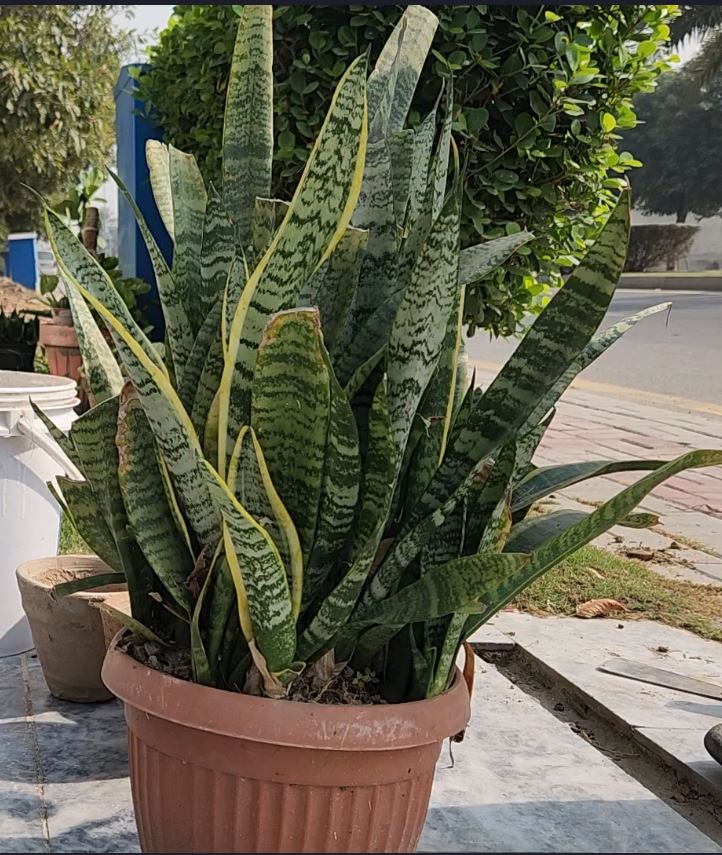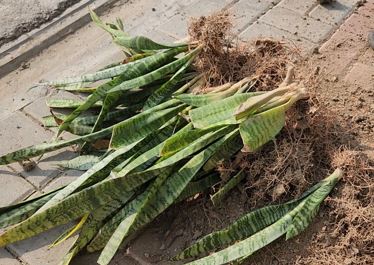Indoor plants for vibrant, fresh living spaces.
How I Separated and Repotted My Big Snake Plant
Imagine this: you glance over at your big snake plant one day, and it just seems a bit… off. You think, “It’s healthy, right?” Then, out of the corner of your eye, you spot it—those roots creeping out of the pot, trying to escape!
So, I take a closer look, and, oh boy, the whole plant looks like it’s in a tiny apartment with way too many roommates. Its pot was of only 10 inch. Growth has hit a standstill, and I can see this plant’s just begging for a bit of space. I mean, when I counted, there were about 20 separate little snake plants crammed into one pot!
I was keeping snake plants outdoor and to think it had been like that for three years. Three years! Imagine the root situation down there. Yup, pretty tangled, some of them even dried out, and the roots? They were a little mix of earthy chaos.

Now, I won’t lie; getting them apart wasn’t exactly a walk in the park. I tugged and wiggled at first, trying to get some space between them. No luck. Those roots had become best friends, and they weren’t about to separate easily. So, out came the gardening tool—I’m talking about a mini hammer for the soil. It helped chip away some of that compacted sand and soil, loosening things up just enough to break the roots free. And after a bit of work, I ended up with a neat lineup of 19 mini snake plants, each in their own little pot.
Now, let’s chat about why this separation and repotting isn’t just a one-time task but more of an annual ritual for these plants. Snake plants, as sturdy and low-maintenance as they are, don’t really thrive long-term when they’re all bunched up like that. Their roots need room to stretch and breathe a little; otherwise, the whole thing just kind of grinds to a halt.
Why Snake Plants Need a Little Yearly TLC
First off, snake plants may not be the drama queens of the plant world, but they still have needs. When the roots start popping out or you’re seeing a slowdown in growth, it’s usually because the plant has filled up the pot to the max. The roots just keep going outside , spiraling around each other until they’re so cramped they can’t really pull in nutrients or water the way they should. Every time they get a little more room, they can grow stronger and even stand taller.
But it’s more than just giving them room to grow. When you repot, you’re also refreshing the snake plant soil mix, which is kind of like giving your plant a whole new pantry of nutrients. Over time, the soil in a snake plant pot loses a bit of its kick. Even if you’re adding fertilizers, old soil can get compacted and kind of worn out. When you repot, you’re giving the roots fresh, nutrient-rich soil to pull from, which means they’ll be healthier and better prepared for a year of new growth.
How to Know When It’s Time for Repotting
Your plant usually lets you know in a few clear ways:
- Roots are creeping out: If you see roots poking out from the drainage holes or the top of the soil, it’s usually a sign they’re desperate for more space.
- Growth stalls: When your snake plant’s growth seems to hit pause, it’s often because the roots don’t have the room or the nutrients to keep pushing out new leaves.
- Soil dries out way too fast: Sometimes, the roots become so packed that they take up most of the pot, leaving very little soil to retain water. If your plant’s drying out much faster than usual, that could be why.
- Plant looks unhappy or droopy: While snake plants are hardy and don’t fuss much, even they start to look a little sad if they’re feeling too cramped.
How to Repot a Snake Plant Without a Hassle
- Prep Your Pots and Snake Plant Soil: Choose pots that are slightly larger than the current ones—snake plants don’t mind being a little snug, but they do need a bit of room. Use well-draining soil, something gritty or sandy is ideal, as snake plants don’t like sitting in soggy soil.
- Gently Remove the Plant: Lay the pot on its side, tap the sides, and wiggle the plant out. If it’s stubborn (and they often are), give it a little encouragement by squeezing the pot or tapping it lightly to loosen things up.
- Separate the Plants: If your pot looks like mine did with multiple plants, separate big snake plants carefully. Pull them apart gently, trying not to break the roots more than necessary. A few breaks here and there are fine, though—they’re tough plants.
- Trim the Roots if Needed: For any dried or overly tangled roots, feel free to give them a trim. It won’t hurt the plant and can encourage fresh, new growth.
- Replant and Water Lightly: Place each plant in its new pot, fill in with soil, and water lightly. Don’t overdo it with water right after repotting; they need some time to adjust before a big drink. Also you need to avoid snake plant root rot after all.

Repotting Brings Out the Best in Your Snake Plant
After a year or so, your snake plant can develop new shoots, and repotting gives each shoot the space it needs to grow into a full plant. You might even see some babies popping up after a few months! It’s almost like getting free plants. Also, having multiple plants potted separately means you have some flexibility. You could keep them all around the house, or maybe even give a few away. Imagine giving a friend a plant with a backstory—they’ll probably appreciate it way more than just a random one from the store.
The result? After a good repotting session, your snake plant’s going to look fresher, feel healthier, and, most importantly, keep thriving. Plus, once you’ve done it, you’ll probably feel a bit of that gardening satisfaction—the kind that makes you feel connected to your plants and know that they’re better off because you’ve given them some attention.
To keep things smooth in the long run, consider setting a little yearly reminder. That way, you won’t be caught off guard by sudden overgrown roots or slow growth. Snake plants might be hardy, but a bit of routine TLC goes a long way. Each year, just a little effort can keep them looking sharp and growing strong for a long, long time.

Final Thoughts
Now that those 19 snake plants have their own space, it’s amazing how they’ve perked up already. There’s something rewarding about seeing each little plant standing tall in its own pot, no longer cramped but thriving. It’s a good reminder that even the most low-maintenance plants sometimes need a little bit of help to keep growing.
And for me, having them spread out in new pots feels like watching them get a fresh start, each one ready to keep the green going. So, if you’re wondering if it’s time to give your plant a little room, take a peek at those roots—you might just have a whole little snake plant family waiting to spread out.

